Tea tonight is going to be a very simple home-made pizza. Simple but satisfying as it will be topped with mozzarella I’ve made from buffalo milk. Buffalo that I had the pleasure of meeting this week.
Before you think I’m sounding either smug or bragging, I have to point out that my mozzarella is obviously far removed from those beautiful silky, smooth little bocconcini that you see in Italian delis. Far more rustic as usual.
Fan as I am of local ingredients though, it’s still very pleasing to make a treat supper from cheese made in my own kitchen. Cheese made from the beautiful creamy white milk of impressive creatures who I’ve seen living a good life.
Although it was cheese-making that drew me to the Water Buffalo farmed at Napton on the Hill in Warwickshire, I’d also heard that buffalo meat is full of flavour yet low in cholesterol and was keen to learn more about these impressive animals.
Roger Alsop, who now produces delicious water buffalo ice-cream as well as buffalo meat (and burgers which he cooks and sells at village shows and festivals), was able to supply me with rich, creamy milk for my mozzarella making, but also enlighten me about buffalo farming. Having spent 25 years dairy farming at Brookend Farm, Roger found that milk quotas made it increasingly difficult to earn a living from milk and decided to diversify. The Alsops bought 20 Water Buffalo and a bull in 1999 and now have a herd of around 250 buffalo.
Roger has been converting his farm to organic and will achieve organic status by April. I was really interested to hear how relatively easy this has been because of the natural, traditional way buffalo (and previously cows) have always been farmed here.
Water buffalo haven’t been over-bred for years to increase yields and so are incredibly hardy and disease-resistant, hardly ever needing antibiotics. Docile, friendly animals, Roger says that they can be very low hassle to farm, with “none of the health problems you often get with dairy cattle; no mastitis, no feet problems.” Roger, who farms the buffalo with his son and nephew, has found that you can’t artificially inseminate water buffalo, so they’re all naturally served and breed really well. They can also milk for 20 years and calf yearly, despite a 10 month gestation period.
All sounds very easy, and Roger agrees that it is – with one exception:
“You just need to accept that you’ll never force a buffalo to do anything that they don’t want to do.”
Docile, friendly creatures who are often happier being milked than cows, buffalo are, however, very stubborn. You can’t drive buffalo like other cattle, but they do come when called: “They’re so inquisitive that they want to know what’s going on.”
When I visited, the Buffalo immediately peered nosily at me, looking as if they were wondering who on earth I was and what I was up to.
They mature slowly and naturally here, in fact everything about this style of farming reminded me that these were creatures to be respected, not commodities as it often seems modern cattle are treated as.
Interestingly, although they may be an unusual sight in Warwickshire, there are actually more water buffalo farmed worldwide than cows. Very popular in Eastern Europe and Asia, in Vietnam water buffalo are often the most valuable possession of poor farmers and treated as a member of the family. Roger Alsop’s herd came from Romania, where buffalo are still a common sight and are used to pull carts.
As with all grass-fed animals the meat is a good source of Omega 3 fatty acids. Full of flavour, it’s also very lean and 40% lower in fat and cholesterol than beef. The milk, although rich and creamy is also low in cholesterol, making it perfect for delicious but healthy ice-cream, cheese and milk-shakes.
The healthy meat can be cooked in the same way as beef but, despite its lack of fat, has a richer, fuller flavour. Roger Alsop lets his buffalo grow slowly and naturally, typically for 3 ½ years and the resulting topside, rump and fillet steaks are fantastic. So tender that it suits quick cooking, buffalo meat is delicious rare or even raw in Carpaccio.
Looking forward to experimenting with buffalo and kidney pies. In the meantime, this is how I made the mozzarella.
I’d previously tried the Hugh Fearnley-Whittingstall method here with cow’s milk. Have to admit that while I’ve been happily experimenting with easy soft cheeses of the world such as paneer, labneh and feta, Mozzarella scared me. I’m certainly not averse to scoffing little stretchy silky balls of fresh Mozzarella with tomatoes from the garden in the Summer and very happy to cook with gloriously melting mozzarella in Italian classics food such as pizza and lasagne. It’s just that all that re-heating whey, cutting and stretching of curds sounded a little bit intimidating.
Once I started making Mozzarella though, I found that, like most cheese-making, as long as you have good milk (preferably unhomogenized) and a decent thermometer, it really isn’t too difficult. My first attempt was a lot firmer than the blissfully silky cheese I’d imagined, probably due to draining too much whey. But even then, a mixture of Mozzarella research and eating it cooked with aubergines in gloriously comforting Melanzane Parmigiana reassured me.
The cheese I made with buffalo milk was a lot softer than the cow’s milk version though. This may have been due to something slightly different in my technique or a different diet eaten by the cows/buffalo but I found it easier to make softer, creamier mozzarella with buffalo milk. My cow’s milk version was tougher in comparison.
Although Hugh (and other Mozzarella recipes I’ve consulted) advises not to knead the mozzarella once you’re at the dipping in hot whey stage (I know, I didn’t think I’d ever tackle this sort of cooking either but it’s honestly a great game) as it results in toughness, I found that kneading rather than cutting into strips was more suited to the buffalo cheese I made. Only dawned on me this week that mozzare means to cut in Italian, hence the name, by the way. Anyway, I used some of the techniques from the New England recipe here for my buffalo mozzarella as moulding and gently kneading into balls seemed to work with this softer cheese.
You can choose to shape the cheese into a couple of large balls or mould into little bocconcini style balls. Dip into a bowl of chilled water, refrigerate and use within two days. Alternatively you can enjoy immediately while still warm, savouring the freshest Mozzarella you’re likely to have.


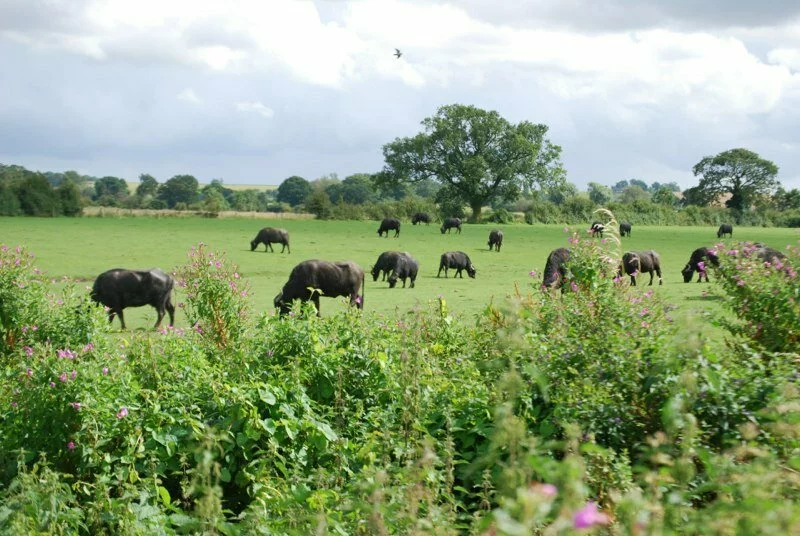
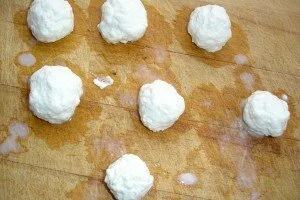
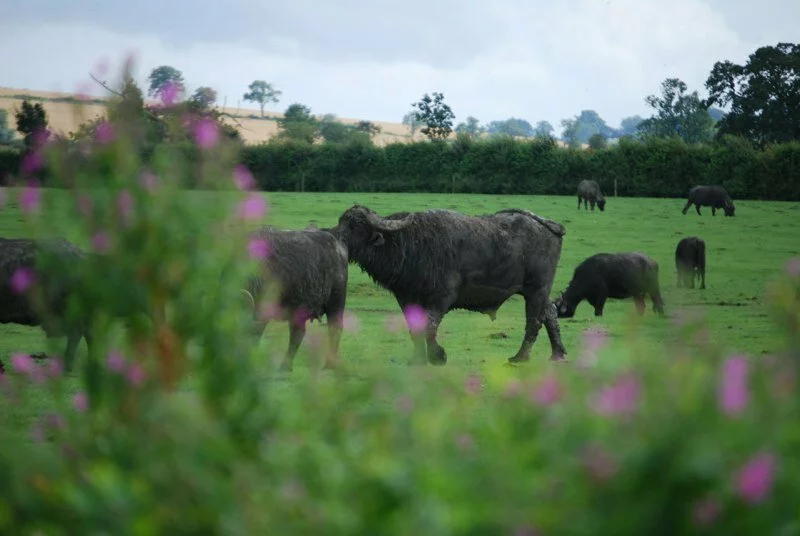
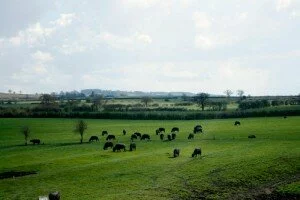
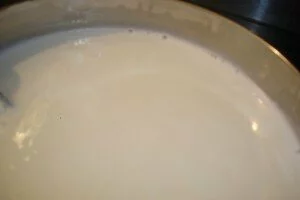
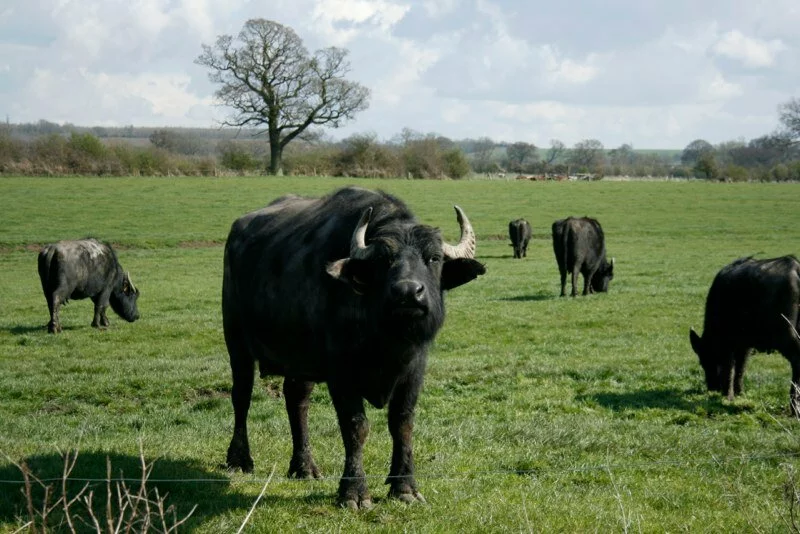
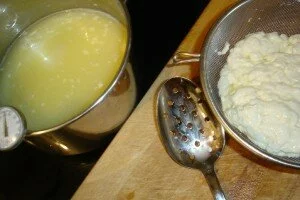
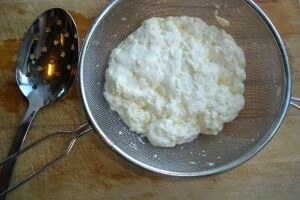
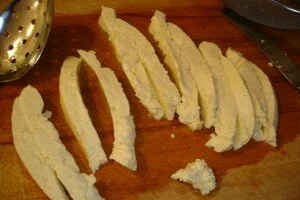
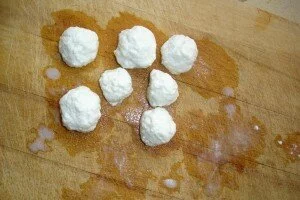
Very impressive and informative, as always. I’m not surprised you found the buffalo milk version superior as this mirrors my experience with commercially produced mozzarella.
Steve
Thanks lots Steve. I’m definitely going to look out for buffalo mozzarella when I buy it now too. Wish I had a buffalo out the back so I could experiment lots with the milk. Think our fences may take a battering though!
Impressive stuff Andrea and, ss you say, good milk is so important.
Thanks Evie. Have to admit my mozzarella didn’t melt on the pizza but it was very tasty – definitely thanks to the lovely milk.
I know someone who sells the the milk and cheese from buffalo in Somerset. I found the milk very creamy and slightly goaty, good though and their mozzarella is excellent. I’m envious that you have the space to make cheese 😉
Interesting, I didn’t know anybody was doing it in Somerset. I know what you mean about the slightly goaty taste, lovely with it though. And you honestly only need a stove and a chopping board to make mozzarella.
I learned so much from this post. How many people can claim to have made cheese from buffaloes they’ve met in person. Talk about ‘slow food’ – how brilliant.
I know, it would’ve been quicker to pop to the supermarket! Not as interesting though, I feel very lucky. So pleased you learnt something (I’m always so fascinated by your blog posts which are always so interesting and well-informed), I came away from the buffalo full of enthusiasm for what I’d learnt too.
Great post Andrea – it must be very satisfying to see the whole process from farm to pizza!
Absolutely, it was so interesting. Even though I’ll hardly be able to do this every time I make pizza, my experiments will definitely make me think differently every time. Will stop to think about where the milk is from and, for artisan cheese, I’ll really appreciate the effort that’s gone into it.
This is fascinating Andrea, well done on the cheese making, it looks delicious. Those buffalo are amazing creatures! Thanks for sharing.
Thanks lots Jane. The cheese making was very amateur – but still a great game. And yes, buffalo are amazing creatures.
FABULOUS post Andre and so interesting too…..it’s always fascinating to see the whole field to fork experience. Karen
Thank you Karen. I did love my field to pizza journey.
Lovely post Andrea, you have some amazing food experiences. In Poland there are lots of buffalo, they make Bison grass vodka and add real sprig of the grass that the bison have roamed around on to give it a ‘characterful’ flavour. Interesting to know that the animal the Americans know as a buffalo is actually a bison. How amazing to have made your very own mozzarella from their milk
I do feel very lucky Ren, I think there are some really interesting foodie things going on within easy reach of the area I live in. Bison grass vodka sounds interesting though. You’ve just triggered off a memory of buffalo vodka in Devon – have you heard of this or have I dreamt it up?!
Great stuff! Lucky you, meeting the buffalo. I really want to get out more this year and meet some proper cheese-makers; it’s been hard with a baby in tow so far. This was fascinating – and your cheese looks good, mine was quite shiny. Still, satisfying though. What are you doing with the leftover whey? I just posted today about my experiments with lacto-fermentation; interesting if not exactly delicious…
It was so interesting seeing the buffalo but yes, I remember how difficult doing things like that was with a baby in tow. Ruby is 6 now so I can fit things like this in during school hours. I love your whey piece – have been meaning to have a go at lacto-fermentation with veg. Just used the whey in pancakes (taste good, like sourdough pancakes) and in ricotta so far. Oh and smoothies which were foul. It’s good in a marinade for meat too, tenderises – have you tried?
What a fascinating post. I had no idea how buffalo are farmed. I don’t eat meat but your article reminded me how majestically we must treat animals that feed and support our economies. Of course not as much as they used to or do in rural communities in India for example where they are revered and looked after like children. You’ve made me want to have a go at this cheese. I too have made labneh but nothing more so I’m inspired by your pictures to give it a go
You’re right and meeting the buffalo really made me think about the way we farm other animals in this country, whether for meat or dairy. Would love to hear if you have a go at mozzarella. Definitely recommend a simple curd cheese if you have good milk to experiment with too.